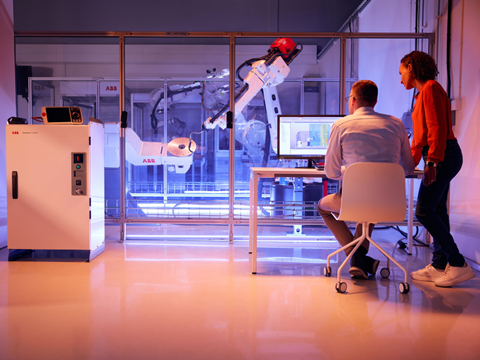
ABB Robotics has launched OmniCore, an intelligent automation platform designed for gluing, laser cutting, and other precise processes. It claims to operate up to 25% faster with 20% less energy than the previous ABB controller.
Stemming from over $170 million (€156,901,500) of investment in next-generation robotics, the OmniCore platform is intended as a development upon modular and futureproof control architecture. It is set to fully integrate AI, sensor, cloud, and edge computing systems into advanced and autonomous robotic applications.
Multiple robots are said to run at speeds of up to 1,600mm per second, with OmniCore thought to provide robot path accuracy at a level of less than 0.6mm and ‘class-leading’ motion performance. As such, it is said to benefit precision areas like gluing, laser cutting, arc welding, mobile phone display assembly.
The platform is built on a scalable, modular control architecture. As such, it is said to be suitable for businesses in various sectors, as its range of over 1,000 hardware and software features can ‘create almost any application imaginable’. ABB’s Absolute Accuracy and PickMaster software, alongside hardware options ranging from external axis and vision systems to fieldbuses, can be used to operate, maintain, and optimize operations with ease, the company adds.
Sami Atiya, president of ABB’s Robotics & Discrete Automation Business Area, commented: “For our customers, automation is a strategic requirement as they seek greater flexibility, simplicity and efficiency in response to the global megatrends of labor shortages, uncertainty and the need to operate more sustainably.
“Through our development of advanced mechatronics, AI and vision systems, our robots are more accessible, more capable, more flexible and more mobile than ever. But increasingly they must also work seamlessly together, with us and each other, to take on more tasks in more places.
“This is why we are launching OmniCore, a new milestone in our 50-year history in robotics; a unique, single control architecture – one platform, and one language that integrates our complete range of leading hardware and software.”
“The OmniCore difference is its ability to manage motion, sensors and application equipment in a single holistic unified system,” explained Marc Segura, division president ABB Robotics. “OmniCore opens the door to the entire ABB Robotics portfolio of hardware and software, in any combination under a single control platform, offering endless possibilities and more avenues for value creation.
“For example, OmniCore enables automotive manufacturers to increase production speed, offering tremendous competitive advantage, increasing press tending production from 12 to 15 strokes per minute to produce 900 parts per hour. As we celebrate our 50th anniversary in Robotics, we believe that OmniCore offers the potential for many more industry breakthroughs, empowering our customers across all sectors to meet the challenges that lie ahead.”
OmniCore will replace ABB Robotics’ IRC5 controller, which will be phased out in June 2026. Any customers utilizing IRC5 will still be supported with spare parts and services until the robot is discontinued.
Last year, ABB revealed its plans to invest $280 million (€258,490,400) into a state-of-the-art Robotics Campus in Sweden. Replacing nine separate buildings, the combined facility is expected to increase production capacity by 50%, increase supply to the European market, lower greenhouse gas emissions, and conserve resources.
ABB Robotics also sought to handle 12kg and 22kg payloads with the IRB 930 pick-and-place robot. It was released as an extension of the SCARA portfolio and is designed for fast, point-to-point tasks in large workspaces with high payloads.
In more recent news, Schubert-Pharma’s automated, top-loading packaging vial machine with a table-top design is expected to help pharmaceutical manufacturers surpass their line clearance requirements.
If you liked this story, you might also enjoy:
How are the top brands progressing on packaging sustainability?
The ultimate guide to global plastic sustainability regulation





















No comments yet